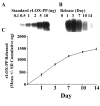Recombinant lysyl oxidase propeptide protein inhibits growth and promotes apoptosis of pre-existing murine breast cancer xenografts
- PMID: 22363577
- PMCID: PMC3280126
- DOI: 10.1371/journal.pone.0031188
Recombinant lysyl oxidase propeptide protein inhibits growth and promotes apoptosis of pre-existing murine breast cancer xenografts
Abstract
Lysyl oxidase propeptide (LOX-PP) ectopic overexpression inhibits the growth of cancer xenografts. Here the ability and mode of action of purified recombinant LOX-PP (rLOX-PP) protein to inhibit the growth of pre-existing xenografts was determined. Experimental approaches employed were direct intratumoral injection (i.t.) of rLOX-PP protein into murine breast cancer NF639 xenografts, and application of a slow release formulation of rLOX-PP implanted adjacent to tumors in NCR nu/nu mice (n = 10). Tumors were monitored for growth, and after sacrifice were subjected to immunohistochemical and Western blot analyses for several markers of proliferation, apoptosis, and for rLOX-PP itself. Direct i.t. injection of rLOX-PP significantly reduced tumor volume on days 20, 22 and 25 and tumor weight at harvest on day 25 by 30% compared to control. Implantation of beads preloaded with 35 micrograms rLOX-PP (n = 10) in vivo reduced tumor volume and weight at sacrifice when compared to empty beads (p<0.05). A 30% reduction of tumor volume on days 22 and 25 (p<0.05) and final tumor weight on day 25 (p<0.05) were observed with a reduced tumor growth rate of 60% after implantation. rLOX-PP significantly reduced the expression of proliferation markers and Erk1/2 MAP kinase activation, while prominent increases in apoptosis markers were observed. rLOX-PP was detected by immunohistochemistry in harvested rLOX-PP tumors, but not in controls. Data provide pre-clinical findings that support proof of principle for the therapeutic anti-cancer potential of rLOX-PP protein formulations.
Conflict of interest statement
Figures









Similar articles
-
Effects of tumor-suppressor lysyl oxidase propeptide on prostate cancer xenograft growth and its direct interactions with DNA repair pathways.Oncogene. 2015 Apr 9;34(15):1928-37. doi: 10.1038/onc.2014.147. Epub 2014 Jun 2. Oncogene. 2015. PMID: 24882580 Free PMC article.
-
Determination of cell uptake pathways for tumor inhibitor lysyl oxidase propeptide.Mol Oncol. 2016 Jan;10(1):1-23. doi: 10.1016/j.molonc.2015.07.005. Epub 2015 Aug 6. Mol Oncol. 2016. PMID: 26297052 Free PMC article.
-
Lysyl oxidase propeptide sensitizes pancreatic and breast cancer cells to doxorubicin-induced apoptosis.J Cell Biochem. 2010 Dec 1;111(5):1160-8. doi: 10.1002/jcb.22828. J Cell Biochem. 2010. PMID: 20717927 Free PMC article.
-
Lysyl oxidase propeptide stimulates osteoblast and osteoclast differentiation and enhances PC3 and DU145 prostate cancer cell effects on bone in vivo.J Cell Commun Signal. 2016 Mar;10(1):17-31. doi: 10.1007/s12079-015-0311-9. Epub 2015 Dec 1. J Cell Commun Signal. 2016. PMID: 26627907 Free PMC article.
-
Lysyl oxidase propeptide inhibits prostate cancer cell growth by mechanisms that target FGF-2-cell binding and signaling.Oncogene. 2009 Sep 24;28(38):3390-400. doi: 10.1038/onc.2009.203. Epub 2009 Jul 13. Oncogene. 2009. PMID: 19597471 Free PMC article.
Cited by
-
Inhibition of LSD1 epigenetically attenuates oral cancer growth and metastasis.Oncotarget. 2017 Jul 27;8(43):73372-73386. doi: 10.18632/oncotarget.19637. eCollection 2017 Sep 26. Oncotarget. 2017. PMID: 29088714 Free PMC article.
-
Association of the G473A polymorphism and expression of lysyl oxidase with breast cancer risk and survival in European women: a hospital-based case-control study.PLoS One. 2014 Aug 20;9(8):e105579. doi: 10.1371/journal.pone.0105579. eCollection 2014. PLoS One. 2014. PMID: 25141126 Free PMC article.
-
Inhibition of angiogenesis in endothelial cells by Human Lysyl oxidase propeptide.Sci Rep. 2018 Jul 11;8(1):10426. doi: 10.1038/s41598-018-28745-8. Sci Rep. 2018. PMID: 29993014 Free PMC article.
-
Effects of tumor-suppressor lysyl oxidase propeptide on prostate cancer xenograft growth and its direct interactions with DNA repair pathways.Oncogene. 2015 Apr 9;34(15):1928-37. doi: 10.1038/onc.2014.147. Epub 2014 Jun 2. Oncogene. 2015. PMID: 24882580 Free PMC article.
-
Lysyl Oxidase Gene G473A Polymorphism and Cigarette Smoking in Association with a High Risk of Lung and Colorectal Cancers in a North Chinese Population.Int J Environ Res Public Health. 2016 Jun 28;13(7):635. doi: 10.3390/ijerph13070635. Int J Environ Res Public Health. 2016. PMID: 27367711 Free PMC article.
References
-
- Kagan HM, Trackman PC. Properties and function of lysyl oxidase. Am J Respir Cell Mol Biol. 1991;5:206–210. - PubMed
-
- Kessler E, Takahara K, Biniaminov L, Brusel M, Greenspan DS. Bone morphogenetic protein-1: the type I procollagen C-proteinase. Science. 1996;271:360–362. - PubMed
-
- Uzel MI, Scott IC, Babakhanlou-Chase H, Palamakumbura AH, Pappano WN, et al. Multiple bone morphogenetic protein 1-related mammalian metalloproteinases process pro-lysyl oxidase at the correct physiological site and control lysyl oxidase activation in mouse embryo fibroblast cultures. J Biol Chem. 2001;276:22537–22543. - PubMed
-
- Palamakumbura AH, Jeay S, Guo Y, Pischon N, Sommer P, et al. The propeptide domain of lysyl oxidase induces phenotypic reversion of ras-transformed cells. J Biol Chem. 2004;279:40593–40600. - PubMed
Publication types
MeSH terms
Substances
Grants and funding
LinkOut - more resources
Full Text Sources
Other Literature Sources
Medical
Research Materials
Miscellaneous

